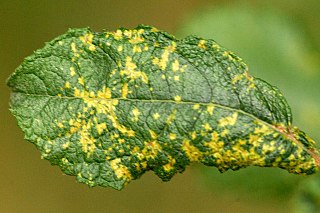
Aceria fraxinivora, also known as the cauliflower gall mite and the ash key gall, causes the growths, known as galls, found on the hanging seeds or "keys" of the ash (Fraxinus) species.

Hartigiola annulipes is a species of midge fly in the family Cecidomyiidae, found in the Palearctic. The fly was first described by Theodor Hartig in 1839. The larvae gall the leaves of beech.

Rabdophaga rosariella is a species of gall midge which forms galls on sallows. It was first described by Jean-Jacques Kieffer in 1897.
Rabdophaga saliciperda is a species of gall midges which forms galls on willows. It was first described by Léon Jean Marie Dufour in 1841.
Rabdophaga albipennis is a gall midge which forms galls on the shoots of white willow.
Rabdophaga karschi is a gall midge which forms galls on the twigs of sallows.

Melampsora caprearum is a fungal pathogen which causes galls on willows. Also known as a rust fungus, it was first described by Felix von Thümen in 1879.
Euura oblita is a species of sawfly belonging to the family Tenthredinidae. The larvae feed on the leaves of willows and was first described by Jean Guillaume Audinet-Serville in 1823.
Euura destricta is a species of sawfly belonging to the family Tenthredinidae. The larvae feed on the leaves of willow.

Rabdophaga nervorum is a gall midge which forms galls on the leaves of sallows. It is found in Europe and was first described by the French entomologist, Jean-Jacques Kieffer in 1895.

Bactericera albiventris is a hemipteran bug in the family Triozidae, which causes galls on the leaves of willows. It was first described by Arnold Förster in 1848.
Euura aquilonis is a species of sawfly belonging to the family Tenthredinidae. The larvae feed internally in a gall formed on the leaves of dwarf willow and polar willow. Galls of E. herbaceae are similar and the larvae need to be examined to tell them apart.
Euura arbusculae is a species of sawfly belonging to the family Tenthredinidae. The larvae feed internally in a gall formed on the leaves of mountain willow.
Euura crassipes is a species of sawfly belonging to the family Tenthredinidae and was first described by Carl Gustaf Thomson in 1871. The larvae feed internally in a gall formed on the leaves of downy willow.

Phyllocoptes goniothorax is a species of mite belonging to the genus Phyllocoptes, which causes galls on the leaves of hawthorns. It was first described by Alfred Nalepa in 1889.

Acalitus brevitarsus is an eriophyid mite which induces domed, blister like swellings, known as galls, on some species of alder.
Acalitus stenaspis is an eriophyid mite which causes galls on beech. It is found in Europe and was first described by the Austrian zoologist Alfred Nalepa in 1891.

Taphrina betulina is a fungal plant pathogen that causes the gall, witches broom, which is a chemical infection of birch buds or the developing shoots, leading to a proliferation of growth. It was first described by Emil Rostrup in 1883 and is found in Europe, New Zealand and North America.
Acalitus calycophthirus is an eriophyid mite which causes big bud galls on birch twigs. It is found in Europe and was first described by the Austrian zoologist, Alfred Nalepa in 1891.

Aceria campestricola, is a species of mite in the family Eriophyidae. The mite causes galls on the leaves of elms and was described by Georg Ritter von Frauenfeld in 1865.











